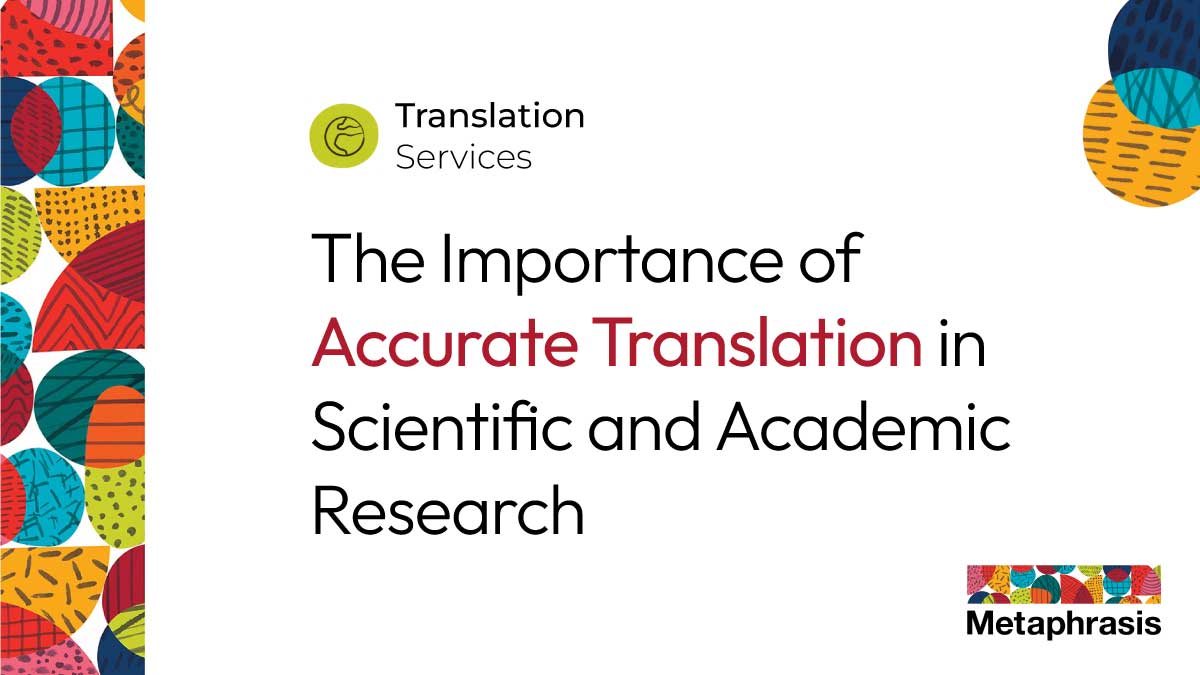
The Importance of Accurate Translation in Scientific and Academic Research
Accurate translation plays a pivotal role in connecting researchers across linguistic and cultural boundaries, fostering understanding, and enabling meaningful collaboration on a global scale. As the world of research becomes increasingly interconnected, the demand for precise and dependable translations continues to grow. Whether it’s translating research papers, academic journals, or thesis documents, maintaining both linguistic accuracy and contextual integrity is essential to preserve the credibility and authenticity of scholarly work.
Academic translation is far more than a simple transfer of words from one language to another—it is a nuanced process that requires expertise in technical terminology, cultural sensitivity, and subject-specific knowledge. When done well, academic translation can significantly enhance the reach, visibility, and impact of research within the global academic community. On the other hand, imprecise or careless translation can lead to confusion, misinterpretation, or even ethical concerns that may compromise the research’s validity.
For those seeking reliable and high-quality academic translations, Metaphrasis offers expert language solutions designed to meet the rigorous standards of scholarly communication. Our team is committed to delivering translations that uphold academic excellence and integrity.
The Role of Translation in Scientific and Academic Research
Enhancing Global Collaboration
Scientific and academic research thrive on international collaboration. Today’s most important discoveries often result from joint efforts between scholars from diverse linguistic and cultural backgrounds. However, language differences can create barriers that hinder the free flow of ideas and information. This is where translation becomes invaluable.
Accurate translation of research papers, reports, and academic articles ensures that crucial findings are accessible to a broader audience, enabling researchers worldwide to build upon one another’s work.
- Breaking Down Language Barriers: Thoughtful translation bridges linguistic divides, allowing findings to be communicated without losing their intended meaning. A carefully translated paper can make the difference between a global breakthrough and an overlooked discovery.
- Promoting International Visibility: High-quality translations not only improve understanding but also enhance the potential for wider recognition. Researchers who provide well-translated versions of their work—or include accurate abstracts and summaries in multiple languages—tend to gain more visibility and citations across international platforms.
Supporting Academic Integrity and Ethical Standards
Academic research must consistently adhere to strict ethical principles, including accuracy, transparency, and accountability. Translation errors can have serious consequences, especially in fields like medicine, law, and the social sciences. A single mistranslation could distort data, misrepresent conclusions, or even lead to real-world harm.
For example, in medical research, a misinterpreted dosage recommendation or inaccurately translated clinical result could lead to unsafe outcomes. The World Health Organization (WHO) underscores that precise translation is fundamental to ensuring patient safety and maintaining the reliability of global health research.
Accurate translation, therefore, is not only a linguistic task it is an ethical responsibility that safeguards both the integrity of the research and the well-being of those who depend on its findings.
Requirements for High-Quality Academic Translations
Producing a high-quality academic translation requires more than fluency in multiple languages. It demands a deep understanding of the subject matter, a commitment to accuracy, and attention to scholarly conventions. Several factors contribute to ensuring excellence in translation:
- Accuracy: Preserving the exact meaning and nuance of the original text is paramount. Every term and concept must be translated with precision.
- Consistency: Maintaining uniformity in terminology, tone, and style across the document is essential, especially in scientific disciplines where even subtle variations can alter interpretation.
- Readability: The translated text should be clear and coherent, allowing native speakers to easily understand complex ideas without losing the author’s original intent.
- Proper Design of References: References, bibliographies, figures, and tables should be carefully reviewed and formatted to align with academic standards and accurately reflect the source material.
By upholding these principles, translators ensure that academic work maintains its scholarly value and credibility, regardless of language.

Tips for Translating Academic Articles
Translating academic and scientific texts is a meticulous process that calls for a blend of linguistic expertise and domain-specific knowledge. The following steps can help ensure precision and clarity throughout the translation process:
Preparation
- Develop a comprehensive glossary of technical terms and compound expressions used in the text.
- Define the translation style early academic and scientific translations should be concise, formal, and unambiguous.
Translation
- Work sentence by sentence to preserve meaning, structure, and logical flow.
- Pay close attention to details, ensuring that every term and data point is faithfully represented without distortion or omission.
Editing and Review
- Compare the translation carefully with the original document to verify accuracy and completeness.
- Edit the text for grammatical correctness, clarity, and stylistic coherence.
- When possible, ask a peer or subject expert fluent in both languages to review the translation for an additional layer of quality assurance.
By following these practices, translators can create versions that are not only linguistically sound but also intellectually faithful to the original work.
The Impact of Machine Translation on Academic Translations
While machine translation tools have made remarkable progress and can be helpful for preliminary understanding, they still fall short when it comes to the complexity and precision required for academic writing. Research has shown that automated translations often introduce errors, particularly in specialized terminology or nuanced academic phrasing. These inaccuracies can mislead readers and undermine the credibility of scholarly work.
Machine translation can serve as a useful starting point, but it should never replace the careful judgment and contextual understanding that only human experts can provide. In academic research, where the smallest error can have significant consequences, human oversight remains indispensable.
Role of Human Post-Editing
To strike a balance between efficiency and accuracy, human post-editing of machine translations has become increasingly important. This process involves skilled translators reviewing and refining machine-generated output to ensure the final version meets professional and academic standards.
Human post-editors correct inaccuracies, enhance readability, and ensure the translated text reflects the tone, context, and intent of the original author. By combining the speed of technology with human insight and sensitivity, post-editing ensures that translations are both efficient and reliable a crucial advantage in today’s fast-paced academic environment.
Conclusion
Accurate translation is at the heart of effective scientific and academic communication. It allows knowledge to flow freely across languages and cultures, encourages collaboration, and supports the ethical standards that uphold research integrity. Whether handled entirely by professional translators or aided by technology, the key lies in human expertise the ability to interpret, adapt, and convey meaning with precision and empathy.
For researchers aiming to share their work globally, investing in professional academic translation is not just a technical step; it is a commitment to excellence, credibility, and cross-cultural understanding.
FAQs
- Why is accurate translation so critical in academic research?
Accurate translation ensures that research findings are interpreted correctly, preventing misunderstandings and maintaining the integrity of academic communication. - Can machine translation be trusted for academic papers?
While machine translation tools are improving, they often struggle with technical terms and nuanced concepts. Human expertise is still necessary to ensure accuracy and clarity. - What makes academic translation different from general translation?
Academic translation requires deep subject knowledge, familiarity with research terminology, and adherence to scholarly conventions, which go beyond simple linguistic conversion. - How can researchers ensure their translations meet academic standards?
Working with professional translators who specialize in academic or scientific fields, and implementing peer reviews or expert editing, helps maintain high standards. - What role does translation play in global academic collaboration?Translation bridges linguistic gaps, allowing researchers worldwide to access, understand, and build upon each other’s work fostering global innovation and progress.
